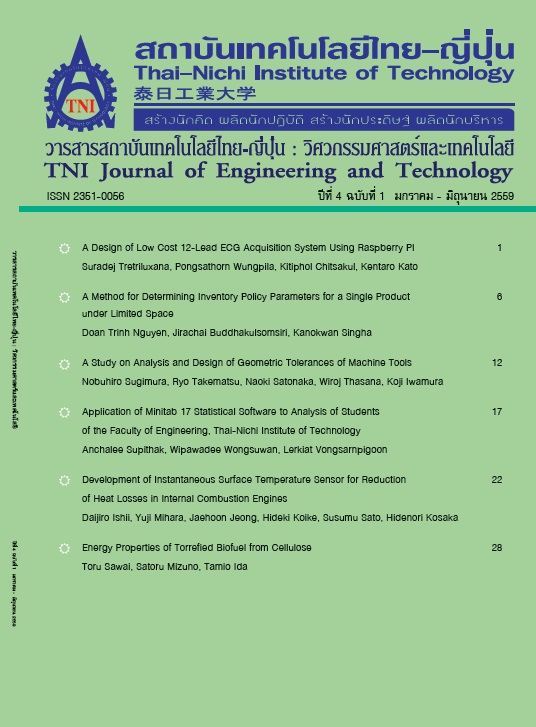Energy Properties of Torrefied Biofuel from Cellulose
Main Article Content
Abstract
Due to the rise of concern for recycling, waste paper to produce recycled paper and paperboard is recovered in individual countries of the world. The global recovery rate is around 58% in 2014. But some paper such as beverage paper containers and the low quality waste paper are not suitable to the material for recycling. The utilization of the above paper as a solid biofuel to replace coal is considered to be reasonable from the standpoint of cascade cyclic utilization of waste biomass. The waste paper is mainly composed of cellulose and has a good property of low water content, but its heating value is two-thirds of coal. In the present study, the cellulose is reformed by the torrefaction and it is assumed that the torrefied biofuel from cellulose is utilized for the biomass and coal co-firing at existing coal power plants. There are two objectives in the present study. The first one is to correlate the energy properties of torrefied cellulose with the mass yield. The second one is to clarify the optimum mass yield condition to produce torrefied biofuel from cellulose using the modified energy analysis model. From the results, it is found that torrefaction has a positive effect on the reduction of carbon dioxide emission in the case that the energy consumptions for production and transportation of torrefied biofuel are relatively high.
Article Details
Article Accepting Policy
The editorial board of Thai-Nichi Institute of Technology is pleased to receive articles from lecturers and experts in the fields of engineering and technology written in Thai or English. The academic work submitted for publication must not be published in any other publication before and must not be under consideration of other journal submissions. Therefore, those interested in participating in the dissemination of work and knowledge can submit their article to the editorial board for further submission to the screening committee to consider publishing in the journal. The articles that can be published include solely research articles. Interested persons can prepare their articles by reviewing recommendations for article authors.
Copyright infringement is solely the responsibility of the author(s) of the article. Articles that have been published must be screened and reviewed for quality from qualified experts approved by the editorial board.
The text that appears within each article published in this research journal is a personal opinion of each author, nothing related to Thai-Nichi Institute of Technology, and other faculty members in the institution in any way. Responsibilities and accuracy for the content of each article are owned by each author. If there is any mistake, each author will be responsible for his/her own article(s).
The editorial board reserves the right not to bring any content, views or comments of articles in the Journal of Thai-Nichi Institute of Technology to publish before receiving permission from the authorized author(s) in writing. The published work is the copyright of the Journal of Thai-Nichi Institute of Technology.
References
Annual Review of Global Pulp & Paper Statistics. BOSTON:RISI, 2015.
X.-R. Li, W.-S. Lim, Y. Iwata, and H. Koseki, “Thermal characteristics and their relevance to spontaneous ignition of refuse plastics/paper fuel,” Journal of Loss Prevention in the
Process Industries, vol. 22, no. 1, pp. 1–6, Jan. 2009.
Z. Kadirova, Y. Kameshima, A. Nakajima, and K. Okada, “Preparation and sorption properties of porous materials from refuse paper and plastic fuel (RPF),” Journal of Hazardous Materials, vol. 137, no. 1, pp. 352–358, Sep. 2006.
J. Kobayashi, K. Kawamoto, R. Fukushima, and S. Tanaka, “Woody biomass and RPF gasification using reforming catalyst and calcium oxide,” Chemosphere, vol. 83, no. 9, pp. 1273–1278, May 2011.
I.-H. Hwang, J. Kobayashi, and K. Kawamoto, “Characterization of products obtained from pyrolysis and steam gasification of wood waste, RDF, and RPF,” Waste Management, vol. 34, no. 2, pp. 402–410, Feb. 2014.
T. Sawai, T. Kajimoto, T. Honjyo, H. Sano, T. Ida, M. Fuchihata, and M. Kaji, “Effect of Citric Acid Addition on Transportation of Semi-Carbonized Fuel,” Journal of the Japan Institute of Energy, vol. 83, no. 10, pp. 782–787, 2004.
T. Sawai, I. Katayama, T. IDA, and T. Kajimoto, “ICOPE-15-1024 Estimation of Energy Density and Energy Yield of Torrefied Biomass with Colorimetric Values,” Proceedings of the International Conference on Power Engineering : ICOPE, vol. 2015, no. 12, Nov. 2015.
T. Honjyo, “Utilization of unused biomass (2); BCDFbiofuel (Bio-carbonized densified fuel) (in Japanese),” Fuel and combustion, vol. 65, pp. 490–497, 1998.
T. Honjyo and H. Sano, “A new biofuel/BCDF, utilization of biomass (in Japanese),” 1998.
H. Sano and T. Honjo, “Principle of Semi-carbonization of Biomass and the Effect on Use,” Journal of High Temperature Society, vol. 37, no. 2, pp. 43–49, 2011.
M. J. C. van der Stelt, H. Gerhauser, J. H. A. Kiel, and K. J. Ptasinski, “Biomass upgrading by torrefaction for the production of biofuels: A review,” Biomass and Bioenergy, vol. 35, no. 9, pp. 3748–3762, Oct. 2011.
W.-H. Chen, J. Peng, and X. T. Bi, “A state-of-the-art review of biomass torrefaction, densification and applications,” Renewable and Sustainable Energy Reviews, vol. 44, pp. 847–
, Apr. 2015.
V. Repellin, A. Govin, M. Rolland, and R. Guyonnet, “Energy requirement for fine grinding of torrefied wood,” Biomass and Bioenergy, vol. 34, no. 7, pp. 923–930, Jul. 2010.
N. Ooiwa, “Evaluation of a new biomassfuel aimed at the improvement in mixed combustion rate (in Japanese),” Chubu electric power news on development of technology, no. 148, pp. 11–12, 2013.
S.A. Channiwala and P. P. Parikh, “A unified correlation for estimating HHV of solid, liquid and gaseous fuels,”Fuel, vol. 81, no. 8, pp. 1051–1063, May 2002.


